Pomeranian Philharmonic
The Ignacy Jan Paderewski Pomeranian Philharmonic (Polish: Państwowa Filharmonia Pomorska imienia Ignacego Jana Paderewskiego) has been at its present site in Bydgoszcz, Poland, since 16 November 1953. The Pomeranian Philharmonic is the musical center of Kujawy-Pomerania Province and also features an outdoor art gallery. It is registered on the Kuyavian-Pomeranian Voivodeship Heritage List.
| Ignacy Jan Paderewski Pomeranian Philharmonic in Bydgoszcz | |
|---|---|
Polish: Filharmonia Pomorska im. Ignacego Jana Paderewskiego | |
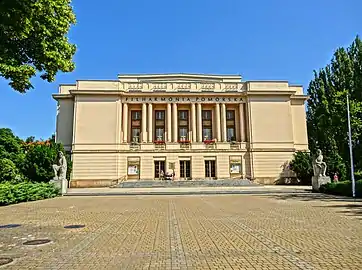 Pomeranian Philharmonic in Bydgoszcz | |

| |
| General information | |
| Architectural style | Neoclassicism |
| Classification | N°601376, Reg.A/269 (January 27, 1978 and December 18, 1981) |
| Address | Andrzej Szwalbe Street 6 |
| Town or city | Bydgoszcz |
| Country | Poland |
| Coordinates | 53°7′44″N 18°00′39″E |
| Construction started | 1954 |
| Completed | 1958 |
| Client | Pomeranian Philharmonic Symphony Orchestra |
| Technical details | |
| Floor count | 2 |
| Design and construction | |
| Architect | Stefan Klajbor |
| Website | |
| filharmonia | |
.JPG.webp)



Location
The seat of the Pomeranian Philharmonic is located in downtown Bydgoszcz, in the center of the "Music District". It is surrounded by Jan Kochanowski Park, music schools, and an outdoor gallery of sculptures of composers and virtuoso musicians.
Characteristics
The Pomeranian Philharmonic is a cultural institution which bodies are under the authority of leading Polish Ministry of Culture and National Heritage and Kuyavian-Pomeranian Voivodeship. Performances include symphonic concerts, chamber music, and recitals by virtuosos from all over the world. On stage Philharmonic concerts are accompanied by Polish or foreign groups, to play at the occasion of jubilees, commemorations and congresses organized by universities and private companies.[1] The repertoire includes music of all periods, from medieval to contemporary works.
The acoustics of the concert hall of the Pomeranian Philharmonic is famous for its quality: concert recordings of classical and contemporary music are often performaed there.[1]
In 2010, the Pomeranian Philharmonic has carried out in their hall 360 concerts, gathering an audience of 79200 people.[2]
The first director of the Pomeranian Philharmonic was, from 1953 to 1991, Andrzej Szwalbe, who made the orchestra of Bydgoszcz a recognized scene in Europe. Since 1991, director is Eleonora Harendarska.
History
Municipal Symphony Orchestra
The first initiative related to set up a Pomeranian Philharmonic was the creation of a local Symphony Orchestra able to perform at a high artistic level: in 1922, one the section of Bydgoszcz's Music Society had an orchestra section under the direction of Zygmunt Urbanyi. However, despite strenuous efforts, no symphony ensemble has been created in the 1920s. In 1924, the Pomeranian Philharmonic Society was an entity consisting of bands from Bydgoszcz, Grudziadz and Torun. In 1925, an initiative to establish an Orchestra of the Pomeranian Philharmonic Society, composed of professional musicians, failed for public foundings reasons.[3] In this situation, the Bydgoszcz Music Society, until 1930, was the only body organizing regular performances:
- outstanding Polish and foreign artists,
- local military bands,
- Bydgoszcz Conservatoire of Music, conducted by Wilhelm von Winterfeld,
- bands from other cities, such as the orchestra of the Grand Theatre of Poznań.[4]
In January 1936, on the initiative of voluntary musicians, the Bydgoszcz symphony orchestra has been created, soon directed by Wilhelm von Winterfeld. The inaugural concert of the Municipal Symphony Orchestra has been held on May 8, 1936 "Strzelnicy Hall" in Toruńska street.[3] The following year, the orchestra was led by Alfons Rezler, a professor of the Municipal Conservatoire of Music, providing the basis for its organization. In 1938, the Bydgoszcz's Music Society took over the patronage of the orchestra,[5] and the Municipality provided a considerable assistance to the team. World War II and the years of occupation have destroyed these achievements: Alfons Rezler died during the invasion of Poland, many musicians were killed or fled abroad.[4]
Pomeranian Symphony Orchestra
In 1946, to celebrate the 600th anniversary of the foundation of Bydgoszcz, a new formation, close to the pre-war Symphony Orchestra of the Music Society of Bydgoszcz was created by Arnold Rezler, Jerzy Jasieński, Felicja Krysiewicz and chaired by Witold Miller.[6] It gave its first concert on May 12, 1946, in the hall of the Pomorski House of Arts in Gdańska Street. From 1946 to 1949, the Music society of Bydgoszcz set up the foundations of the organisation and the material, with few interference of the city.[7] During this period the orchestra was called Pomeranian Symphony Orchestra' of the Bydgoszcz Music Society.
Public concerts were held four times a month, with additional ones in schools of Bydgoszcz and of the Voivodeship. Already at that time, initiatives to invite eminent conductors (Witold Rowicki and Bohdan Wodiczko[8] and soloists started (Stanisław Szpinalski, Zbigniew Drzewiecki, Regina Smendzianka, Kazimierz Wiłkomirski, Wanda Wiłkomirska).[7] Conducting Orchestra, among others, .
In 1949, Mieczyslaw Tomaszewski was nominated as new director: he organized three series of concerts related to Frédéric Chopin (for the centenary of the composer's death), and presented a series of concerts "Music for All" in 26 cities of the Voivodeship. The orchestra was nationalized in November 1950.[6] On September 1, 1951, Andrzej Szwalbe became director of the Pomeranian Philharmonic Orchestra. He soon championed the project of the construction of a specific building for the Philharmonic, to move out of the Pomorski House of Arts in Gdańska Street. Main conductors at this time were, among others Edward Bury, Tadeusz Wilczak or Robert Satanowski.[5] The inaugural concert of the new symphony orchestra of the State Pomeranian Philharmonic took place on January 9, 1953, in the hall of the Polish Theatre.[9]
In September 1955, the orchestra of the National Pomeranian Philharmonic, numbering 65 musicians, was augmented by disbanded musicians from the Bydgoszcz Polish Radio Orchestra. In the same year the name of the institution was changed to Ignacy Jan Paderewski Pomeranian Philharmonic,[8] earning the esteem of more and more talented graduates of music schools. In 1971, the philharmonic counted more than 100 people. Many of the orchestra musicians began working in music schools of Bydgoszcz and Torun.[9]
On November 15, 1958, the orchestra performed its first concert in the brand new building of the Pomeranian Philharmonic in Bydgoszcz.
Pomeranian Philharmonic
In September 1951, Andrzej Szwalbe has been appointed director of the Pomeranian Philharmonic Orchestra, which was nationalized in December 1952: on January 1, 1953, the orchestra was renamed National Pomeranian Philharmonic in Bydgoszcz. Already in February 1953, attempts to have a new philharmonic concert hall have been made,[5] and thanks to the efforts of the Social Committee for the Philharmonic Building, on June 26, 1954 the ceremony laying the foundation stone of the edifice at Libelta street 16 happened. The construction was completed in autumn 1958: the new building was spacious, had a convenient location, and most of all have a concert hall with rare acoustic conditions. On November 16, 1958 a gala concert marking the opening of the new building was held, led by Zbigniew Chwedczuk.[5] During the following days an occasional music festival took place, with concerts were in Bydgoszcz, Torun and Włocławek. At the same time, the Philharmonic was christened Ignacy Jan Paderewski, whose half-brother Józef lived in Bydgoszcz from 1926 until his death in 1958.[9]
Thanks to Andrzej Szwalbe's work, 1961 was the year of the first musical event on a national scale, the "Ignacy Jan Paderewski International Piano competition" (Polish: Międzynarodowy Konkurs Pianistyczny im. Ignacego Jana Paderewskiego). Since then, each year is organized a "Bydgoszcz Music Festival".[5]
The exceptional acoustic of the concert hall drew to Bydgoszcz best artists from all around the world,[10] among others, Witold Małcużyński (1959), Arthur Rubinstein (1960), David Oistrakh (1961), Benjamin Britten (1961), Sviatoslav Richter (1963), Arthur Moreira Lima (1965), Bernard Ringeissen (1965), Ruggiero Ricci (1969), Garrick Ohlsson (1973), Grigori Zhislin (1977), Eugen Indjic, Vadim Brodsky, Stanislav Bunin (1986), Halina Czerny-Stefańska, Maurizio Pollini, Wanda Wiłkomirska, Teresa Żylis-Gara, Krystian Zimerman, Konstanty Andrzej Kulka, George Byrd, Shlomo Mintz, Mischa Maisky, Kevin Kenner, Kurt Masur, Kazimierz Kord, Jerzy Maksymiuk, Antoni Wit. Among the conductors, we one can mention: Leopold Stokowski (1960), Aram Khachaturian (1962), Carlo Zecchi (1967), Emil Gilels (1967), Arvīds Jansons. In 1964, Luciano Pavarotti, still unknown, performed here. The Symphonic Orchestra toured well-known orchestra hall worldwide, like New York City, Beijing, Paris, Berlin or Moscow.[5]
In 1962 at the Philharmonic was founded the ancient music ensemble, named Capella Bydgostiensis: the band performs songs of old masters, earning the recognition of amateurs of ancient music in Poland and abroad. In 1966, Andrej Szwalbe organized, in cooperation with the Bydgoszcz Scientific Society and the Department of Musicology of the University of Warsaw, the first festival of ancient music "Musica Antiqua Europae Orientalis".[11] Happening every three years, it is now a well-known event in the worldwide musical life. From 1963 to 1967, the Pomeranian Philharmonic hosted the Festival of Polish Music, later revamped into "Bydgoszcz Music Festival".[5]
As a homage to his major contributions to the development of the Philharmonic and his outstanding cultural role, brought her longtime manager, Andrej Szwalbe has been nominated "Honorary Citizen of Bydgoszcz". Another of his realizations is the inception of the "music district", surrounding the building of the Philharmonic Music and comprising the Bydgoszcz Music Academy - "Feliks Nowowiejski" and the sculpture gallery of composers and virtuosos. On the front square of the Philharmonic has been built in the 1970s an organ-shaped fountain.
Inside, the lobby is decorated with a collection of tapestries. Interiors are adorned with a collection of portraits and busts of prominent composers and an exhibition of historic pianos, as well as rich music library.[5]
Philharmonic building
History
Pomeranian Philharmonic building has been built in the Polish vogue style in the 1940s and 1950s, which is a mix of functionalism, Neoclassical architecture, Renaissance architecture, Baroque architecture and Rococo. The external architecture reveals itself especially neoclassical, displaying seriousness and moderation to illustrate the social importance of the institutions housed there.[12] The originator and effective executor of the building was director of the Philharmonic Andrzej Szwalbe. On March 24, 1953, the Presidium of the Provincial Council in consultation with the Central Board of Opera, Philharmonic Hall and Musical Institutions in Warsaw adopted a resolution allowing the construction of the building. Initial draft were prepared by a team led by the architect Jan Kossowki, who at the time already worked on several projects in Bydgoszcz (Freedom Monument, buildings in Jagiellońska street and Gdańska Street). Many locations were identified: People Park, Jan Kochanowski park, Copernicus square or Leszek the White square. The selected area was the location of former tennis courts at Słowackiego street.[12] The jury, chaired by professor Piotr Biegański who co-led the reconstruction Old and New Town of Warsaw, elected the team headed by:
- architect Stefan Klajbor (who realized a building in Jagiellońska street),
- designer Bogdan Piestrzyński,
- acoustics designer Witold Straszewicz of Warsaw University of Technology.[12]
Construction began in February 1954, under the supervision of Zbigniew Arciszewski from Gdansk University of Technology.[13] The construction was financed by the "Social Reconstruction Fund of the Capital". The building site was twice inspected by a delegation of Soviet builders from Warsaw's Palace of Culture and Science in September 1954 and January 1955. The building was erected using Polish building materials, with the help of Polish engineering and manpower. The interior decor was designed by a team of artists from Torun-Stefan Zarębski, Joseph Kozlowski and Jozef Kowalczyk-, wood panelling prepared by Bydgoszcs's Furniture Factory, railings by Blacksmith craftmen from Gdańsk and chandelier by Szklarska Poręba glassworks which provided chandeliers for Warsaw Palace of Culture and Science.[12]
A particular attention has been paid to concert hall acoustic. The main hall has an amphitheater slope. Over the stage, acoustic reflectors are placed on the back wall, and the whole interior is paneled in order to obtain balanced reverberation time through the entire frequency spectrum. Acoustic effects of this arena amazes even professionals. In a letter to the then Minister of Foreign Affairs Adam Rapacki, Andrzej Szwalbe stated:
"acoustics were able to reach excellence. There is nothing to be ashamed of with regards to the East or the West [...] "

Architecture
The building is an 18m high regular structure with dimensions of 35m by 45m, reminding willingly the features of the Warsaw Phiharmonic building rebuilt at the same period (1955). The main elevation is mounted on a pedestal. The central part of the frontage displays a two-storey high colonnade, joined at its bottom by baluster railings. Facades are topped with attic style cornices with wire mesh walls. Terraces are available between each facade colonnades.
Inside are two concert halls:
- the main one called "Arthur Rubinstein Hall" with an 880 seats capacity
- a smaller one called "Mikołaj Zieleński hall" with 195 seats.
Early in the 1950s, live broadcast occurred thanks to Kuyavian-Pomeranian Voivodeship radio resources, airing both intimate recordings, as well as great symphony orchestra concerts with a choir, with up to 300 people.[14] Around the buildings are displayed sculptures, part of the outdoor monument gallery.[12]
The Pomeranian Philharmonic building has been registered on the Kuyavian-Pomeranian Voivodeship Heritage List N°601376 Reg.A/269 on January 27, 1978 and December 18, 1981.[15]
Acoustics
The main concert hall of the Pomeranian Philharmonic is classified as acoustically one of the best in Europe, as confirmed by well-known artists and music critics.[16] In the background of the main concert hall is set up a mechanical organ produced by the firm Riger-Kloss from Krnov (Czech Republic). The chamber hall is equipped with an organ made by the establishment of Stefan Truszczyński from Włocławek. There is also a large collection of concert keyboards, pianos and harpsichords.[14]
Its excellent acoustics gives to the Pomeranian Philharmonic a fame among well-known artists, being regularly the site of professional recording for music publishers. In this location has been realised Poland's first 24-karat gold audio Compact Disc.
_(14).JPG.webp)
Interior
The Pomeranian Philharmonic has a large collection of art works that are exhibited in the lobby and halls: sculptures, paintings and graphic/textile art works.[17]
The Gallery of Composers Portraits provides an overview of contemporary sculptures. Works have been realized by authors such as: Adam Myjak, Kazimierz Gustaw Zemła, Barbara Zbrożyna, Marian Konieczny, Alfons Karny, Ryszard Wojciechowski or Michał Kubiak. Among the artists portrayed are Frédéric Chopin, Ignacy Jan Paderewski, Mieczysław Karłowicz, Karol Szymanowski, Ludomir Różycki, Józef Koffler, Artur Malawski, Bolesław Szabelski, Witold Małcużyński, Wojciech Kilar, Henryk Górecki, Arthur Rubinstein, Tadeusz Baird, Stefan Kisielewski, Krzysztof Penderecki, Witold Lutosławski.
In the first floor lobby are paintings and graphics of contemporary Polish authors: Jerzy Nowosielski, Zdzisław Beksiński, Jan Tarasin, Władysław Hasior and others.
The Gallery of tapestries includes about 30 tapestries woven from 1983 to 1992 by the traditional manufactories of Gdańsk and Zakopane. Their authors are painters like Mieczysław Olszewsk, Kiejstut Bereźnicki, Kazimierz Ostrowski, Jerzy Zabłocki, Tadeusz Brzozowski, Kazimierz Śramkiewicz. The collection consists of 5 thematic cycles:[17]
- (I) Polish Concert (I, stands in the main lobby and presents historical aspects of Poland history),
- (II) Harmony of the Spheres and the Mare Nostrum,
- (III) Plants and Animals,
- (IV) Concert Zapustny,
- (V) Grotesque.
First tapestries measuring 4m by 2.5 m, designed by Gdańsk artists, have been hung on the walls of the lobby in 1983. Part of the collection adorned the Polish pavilion at the Seville Expo '92 World's fair.[18]
 Main hall rehearsal
Main hall rehearsal Main concert hall
Main concert hall Chambre music hall
Chambre music hall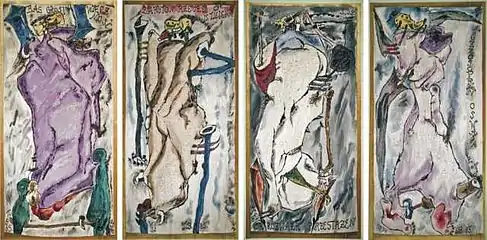 Tapissery Concert Zapustny by Tadeusz Brzozowski: (left to right) "Bass, eternity" "Baritone, existence" "Tenor,space" "Mezzo-soprano, time"
Tapissery Concert Zapustny by Tadeusz Brzozowski: (left to right) "Bass, eternity" "Baritone, existence" "Tenor,space" "Mezzo-soprano, time"
Collections
The Piano Collection of the Pomeranian Philharmonic comprises 54 instruments. These are historical instruments, mainly from the 19th century: pianos, clavichords, player pianos and harmonichords coming from Paris, Berlin, Leipzig, St. Petersburg, London, Vienna, Cologne, Riga, Stuttgart, Warsaw, Krakow, Gdańsk, Wrocław, Kalisz and Bydgoszcz. Purchases of these instruments began in 1970, under the direction of Andrzej Szwalbe. The first instrument was apiano winger, from Kaliningrad firm "Gebauhr" (ca 1875). The oldest exhibit is a table piano for children, produced by Vienna company "Nurnberg Amberberga" (ca 1800). One of the instrument of 1890 has been donated by composer Zygmunt Noskowski. Other exhibits worth mentioning are: a Parisian harmonichord, an English player piano, table pianos playing a record of Janczarski (drums and bells), pianos from Bydgoszcz factory "Bruno Sommerfeld" located from 1905 to 1945 in Dworcowa Street.[5] In 1985, pianos were moved to Ostromecko Palace, but due to renovation, they were stored in warehouses. In 1999 a concept exhibition have been realized in the musical instruments museum in Bydgoszcz.[19]
The collection in Ostromecko Palace is now reopened as "The Andrzej Szwalbe Collection".[20]
The Harpsichord Collection has been established in 1976, by director Andrzej Szwalbe who was inspired by the activity of the band "Capella Bydgostiensis" specialized in playing on Early music instruments. In the 1970s, four harpsichords, replicas of 16th-18th centuries French and Flemish historical instruments, were brought from United States. In the 1980s harpsichordists from across Poland played on these instruments, documenting their recording with the Polskie Radio. Later on, Bydgoszcz collection ushered in a new era for the executive practice of harpsichord in Poland.[21]
Sculpture gallery
The Sculpture gallery of composers and virtuosos consists of busts and monuments located in the interiors and surroundings of the Pomeranian Philharmonic building.
History
This gallery has been created with the initiative of Andrzej Szwalbe, the longtime manager of the Pomeranian Philharmonic.[22]
The ensemble comprises two parts:
- Interior gallery, inside the building;
- Outdoor gallery with portraits, busts and statues of world music greatest composers world music, placed in the Park Jan Kochanowski around the building of the Philharmonic.
The nature and objectives of the whole gallery were designed by Andrzej Szwalbe. In the course of several years he held the unveiling of monuments with participation of the living artists in the halls and corridors of the Pomeranian Philharmonic, generally associated with special concerts. Gallery is a review of Polish sculpture from the late 1950s to the 1990s: each work reveals specific characteristics of its sculptor and the original psychological approach of each character.
Indoor gallery
Inside the building of the Pomeranian Philharmonic are placed the following busts:
- Ignacy Jan Paderewski (granit) by Alfons Karny (1958);
- Mieczysław Karłowicz (gypsum) by Alfons Karny (1959);
- Karol Szymanowski (concrete) – by Alfons Karny (1959);
- Krzysztof Penderecki (bronze) – by Marian Konieczny (1979);
- Wojciech Kilar (bronze) – by Jan Kucz (1979);
- Henryk Mikołaj Górecki (bronze) – by Ryszard Wojciechowski (1979);
- Bolesław Szabelski – by Kazimierz Gustaw Zemła (1979-1980);
- Michał Spisak (bronze) – by Jan Kucz (1980);
- Henryk Mikołaj Górecki (bronze) – by Jan Kucz (1980);
- Witold Lutosławski (bronze) – by Barbara Zbrożyna (1980);
- Anna Maria Klechniowska – by Ludwika Nitschowa (1980);
- Tadeusz Baird – by Andrzej Kasten;
- Artur Malawski – by Adam Myjak;
- Emil Młynarski – by Wiktor Gajda;
- Artur Rubinstein – by Ryszard Wojciechowski;
- Stefan Kisielewski – by Michał Kubiak (1994);
- Andrzej Szwalbe – by Michał Kubiak (1996);
 Bust of Arthur Rubinstein by Ryszard Wojciechowski
Bust of Arthur Rubinstein by Ryszard Wojciechowski Bust of Krzysztof Penderecki by Marian Konieczny, 1979
Bust of Krzysztof Penderecki by Marian Konieczny, 1979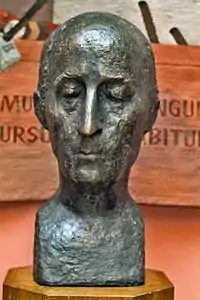 Bust of Witold Lutosławski by Barbara Zbrożyna, 1980
Bust of Witold Lutosławski by Barbara Zbrożyna, 1980 Bust of Wojciech Kilar by Jan Kucz, 1979
Bust of Wojciech Kilar by Jan Kucz, 1979
Outdoor gallery
The area around the Pomeranian Philharmonic building is called "the Music District". Jan Kochanowski Park features 15 monuments (10 statues and 5 busts) of composers and virtuoso musicians.[22] The first monuments, to Chopin and Paderewski, were placed in 1973–75.[22]
Monuments:
- Grażyna Bacewicz, statue in stone by Ewelina & Henryk Szczech-Siwicka;
- Johann Sebastian Bach, bust in bronze by Witold Marciniak;
- Ludwig van Beethoven, statue in bronze by Witold Marciniak;
- Chopin, statue in stone by Józef Makowski;
- Claude Debussy, bust in bronze by Andrzej Kasten;
- Antonín Dvořák, bust in bronze by Witold Marciniak;
- Mieczysław Karłowicz, statue in stone by Henryk Rasmus;
- Karol Kurpiński, statue in bronze by Ewelina & Henryk Szczech-Siwicka;
- Stanisław Moniuszko, statue in stone by Witold Marciniak;
- Paderewski, Statue in stone by Józef Makowski;
- Sviatoslav Richter, bust in bronze;
- Ludomir Różycki, bust in bronze by Mieczysław Welter;
- Igor Stravinsky, bust in bronze by Barbara Zbrożyna;
- Andrzej Szwalbe, statue in bronze by Michał Kubiak;
- Karol Szymanowski, statue in stone by Ewelina & Henryk Szczech-Siwicka;
- Pyotr Ilyich Tchaikovsky, statue in bronze by Ewelina & Henryk Szczech-Siwicka;
- Henryk Wieniawski, statue in stone by Ewelina & Henryk Szczech-Siwicka.
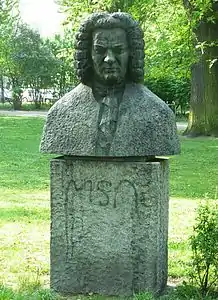 Johann Sebastian Bach, by Witold Marciniak
Johann Sebastian Bach, by Witold Marciniak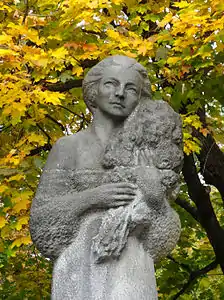 Bacewicz, by Ewelina & Henryk Szczech-Siwicka
Bacewicz, by Ewelina & Henryk Szczech-Siwicka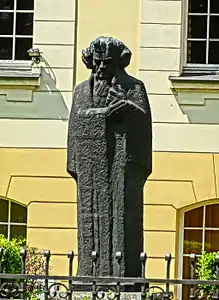 Beethoven, by Witold Marciniak
Beethoven, by Witold Marciniak Chopin, by Józef Makowski
Chopin, by Józef Makowski Debussy, by Andrzej Kasten
Debussy, by Andrzej Kasten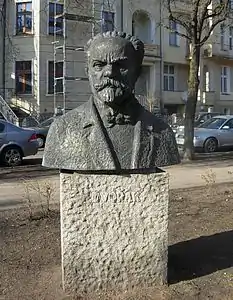 Dvořák, by Witold Marciniak
Dvořák, by Witold Marciniak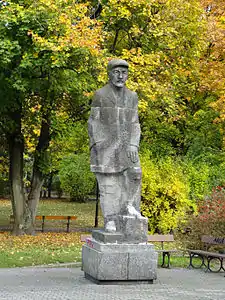 Karłowicz, by Henryk Rasmus
Karłowicz, by Henryk Rasmus Kurpiński, by Ewelina & Henryk Szczech-Siwicka
Kurpiński, by Ewelina & Henryk Szczech-Siwicka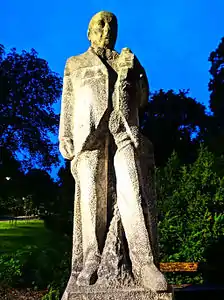 Moniuszko, by Witold Marciniak
Moniuszko, by Witold Marciniak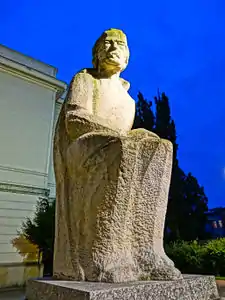 Paderewski, by Józef Makowski
Paderewski, by Józef Makowski
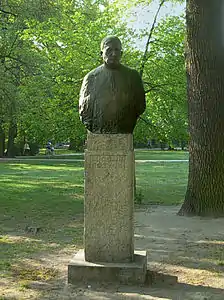 Różycki, by Mieczysław Welter
Różycki, by Mieczysław Welter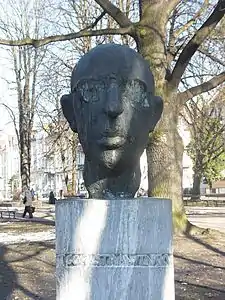
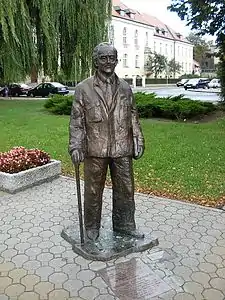 Andrzej Szwalbe, by Michał Kubiak
Andrzej Szwalbe, by Michał Kubiak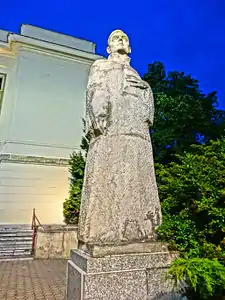 Szymanowski, by Ewelina & Henryk Szczech-Siwicka
Szymanowski, by Ewelina & Henryk Szczech-Siwicka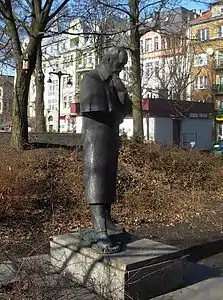 Tchaikovsky, by Ewelina & Henryk Szczech-Siwicka
Tchaikovsky, by Ewelina & Henryk Szczech-Siwicka Wieniawski, by Ewelina & Henryk Szczech-Siwicka
Wieniawski, by Ewelina & Henryk Szczech-Siwicka
See also
| Wikimedia Commons has media related to Ignacy Jan Paderewski Pomeranian Philharmonic in Bydgoszcz. |
| Wikimedia Commons has media related to Sculpture gallery of composers and virtuosos. |
References
- Weber, Alicja (1995). Bydgoszcz muzyczna. Bydgoszcz: Kalendarz Bydgoski.
- "LOCAL DATA BANK". LOCAL DATA BANK. stat.gov.pl. 2017. Retrieved 1 April 2017.
- Perlińska, Anna (1984). Zanim odbył się pierwszy koncert. Bydgoszcz: Kalendarz Bydgoski.
- Pruss Zdzisław Weber Alicja, Kuczma Rajmund (2004). Bydgoski leksykon muzyczny. Bydgoszcz: Kujawsko-Pomorskie Towarzystwo Kulturalne. p. 663.
- Łukaszek, Ewa (1984). 35 lat Filharmonii Pomorskiej. Bydgoszcz: Kalendarz Bydgoski.
- Przecherko, Tadeusz (2003). Osiemdziesiąt lat minęło... Kalendarz Bydgoski.
- Denisuk, Andrzej (1989). Z działalności Towarzystwa Muzycznego w Bydgoszczy. Bydgoszcz: Kronika Bydgoska X.
- Sucharska, Anna (1988). Kultura w Bydgoszczy w latach 1945-1980- Bydgoszcz wczoraj i dziś 1945-1980. Bydgoskie Towarzystwo Naukowe. Państwowe Wydawnictwo Naukowe Warszawa-Poznań.
- Pruss Zdzisław Weber Alicja, Kuczma Rajmund (2004). Bydgoski leksykon muzyczny. Bydgoszcz: Kujawsko-Pomorskie Towarzystwo Kulturalne. p. 420.
- Puto Maciej: Festiwal gwiazd. Kalendarz Bydgoski 2003
- Bloch, Maria (1997). Muzyczne wspomnienie dojrzałego melomana (w 50-lecie Filharmonii Pomorskiej). Bydgoszcz: Kalendarz Bydgoski.
- Wysocka, Agnieszka. Historia budowy bydgoskiej Filharmonii Pomorskiej. Bydgoszcz: Materiały do dziejów kultury i sztuki Bydgoszczy i regionu. zeszyt 13.
- Pruss Zdzisław Weber Alicja, Kuczma Rajmund (2004). Bydgoski leksykon muzyczny. Bydgoszcz: Kujawsko-Pomorskie Towarzystwo Kulturalne. p. 216.
- Bartnicki, Jerzy (1984). Filharmonia Pomorska - Kultura bydgoska 1945-1984. Bydgoszcz: Bydgoskie Towarzystwo Naukowe.
- zabytek-kujawsko-pomorskie-28.02.2014
- Jerzy Waldorff described it as "miracle acoustic" hall
- Puto, Maciej (2004). Gobeliny w filharmonii. Bydgoszcz: Kalendarz Bydgoski.
- Pruss Zdzisław Weber Alicja, Kuczma Rajmund (2004). Bydgoski leksykon muzyczny. Bydgoszcz: Kujawsko-Pomorskie Towarzystwo Kulturalne. p. 174.
- Pruss Zdzisław Weber Alicja, Kuczma Rajmund (2004). Bydgoski leksykon muzyczny. Bydgoszcz: Kujawsko-Pomorskie Towarzystwo Kulturalne. p. 272.
- Polish pianos collecions site
- Pruss Zdzisław Weber Alicja, Kuczma Rajmund (2004). Bydgoski leksykon muzyczny. Bydgoszcz: Kujawsko-Pomorskie Towarzystwo Kulturalne. p. 72.
- Gliwiński, Eugeniusz (1998). Bydgoskie pomniki naszych czasów cz. 2. Bydgoszcz: Kalendarz Bydgoski.
Bibliography
- (in Polish) Bartnicki, Jerzy (1984). Filharmonia Pomorska. Kultura bydgoska 1945-1984. Bydgoszcz: Bydgoskie Towarzystwo Naukowe.
- (in Polish) Bloch, Maria (1997). Muzyczne wspomnienie dojrzałego melomana (w 50-lecie Filharmonii Pomorskiej). Kalendarz Bydgoski. Bydgoszcz: Towarzystwo Miłosnikow Miasta Bydgoszczy. pp. 130–132.
- (in Polish) Łukaszek, Ewa (1984). 35 lat Filharmonii Pomorskiej. Kalendarz Bydgoski. Bydgoszcz: Towarzystwo Miłosnikow Miasta Bydgoszczy. pp. 43–47.
- (in Polish) Perlińska, Anna (1984). Zanim odbył się pierwszy koncert. Kalendarz Bydgoski. Bydgoszcz: Towarzystwo Miłosnikow Miasta Bydgoszczy. pp. 48–50.
- (in Polish) Pruss Zdzisław, Weber Alicja, Kuczma Rajmund (2004). Bydgoski leksykon muzyczny. Bydgoszcz: Kujawsko-Pomorskie Towarzystwo Kulturalne.
- (in Polish) Puto, Maciej (2003). Festiwal gwiazd. Kalendarz Bydgoski. Bydgoszcz: Towarzystwo Miłosnikow Miasta Bydgoszczy.
- (in Polish) Puto, Maciej (2004). Gobeliny w filharmonii. Kalendarz Bydgoski. Bydgoszcz: Towarzystwo Miłosnikow Miasta Bydgoszczy.
- (in Polish) Weber, Alicja (1995). Bydgoszcz muzyczna. Kalendarz Bydgoski. Bydgoszcz: Towarzystwo Miłosnikow Miasta Bydgoszczy. pp. 114–121.
- (in Polish) Wysocka, Agnieszka. Historia budowy bydgoskiej Filharmonii Pomorskiej. Materiały do dziejów kultury i sztuki Bydgoszczy i regionu. zeszyt 13. Bydgoszcz: Pracownia Dokumentacji i Popularyzacji Zabytków Wojewódzkiego Ośrodka Kultury w Bydgoszczy.
- (in Polish) Gliwiński, Eugeniusz (1998). Bydgoskie pomniki naszych czasów cz. 2. Kalendarz Bydgoski. Bydgoszcz: Towarzystwo Miłosnikow Miasta Bydgoszczy. pp. 95–100.
